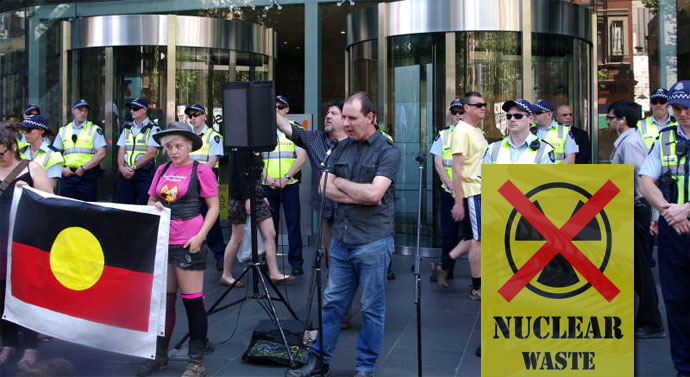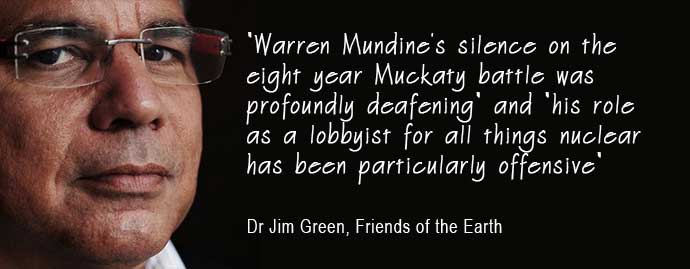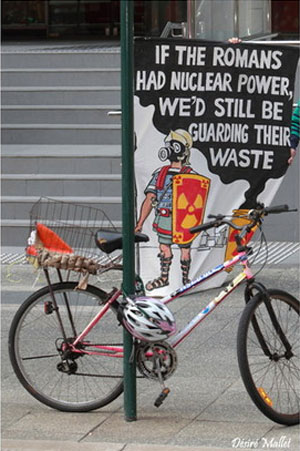Why Australia should not become the world's nuclear waste dump
It is little wonder that Hawke's efforts at a treaty with Aboriginal Australia failed when the best plan he can envisage for lifting communities out of poverty is to offer a toxic trade-off for access to basic services that all other citizens enjoy. This really demonstrates how bereft of responsible policy ideas some politicians are, both in regards to tackling Aboriginal disadvantage and dealing responsibly with the nation's growing radioactive waste problem.

Jim Green 9 August 2014
Former prime minister Bob Hawke is urging Australia to become the world's nuclear waste dump. But he has little hope of succeeding.
Hawke said Australia could end the disadvantage endured by its Indigenous population by opening up traditional lands as dumping sites for nuclear waste from around the world.
UPDATE 20 August 2016 (3cr Radioactive)
This would "finally eliminate these disgraceful gaps in well-being and lifetime opportunities”, Hawke said — an echo of his grandiose claim in 1987 that, "By 1990, no Australian child will be living in poverty."
There are simpler and safer methods to close the gap. For starters, the government could reverse planned cuts of $500 million from Indigenous spending over the next five years. Hawke has been silent about those funding cuts.
Likewise, Warren Mundine — head of the federal government's Indigenous Advisory Council and another supporter of dumping nuclear waste on Aboriginal land — has not protested the funding cuts.

In 2005, Hawke promoted Australia as the world's nuclear waste dump, claiming that: "If we were to do that, we would have a source of income — forget about current account deficit. ... We can revolutionise the economics of Australia if we did this."
Nuclear utilities would certainly pay handsomely to dump nuclear waste in Australia, but the sums involved would not come close to revolutionising Australia's economy, nor would they fundamentally alter patterns of Aboriginal poverty and disadvantage.
In 2009 Hawke said: "I have spoken to Aboriginal leaders and to people from the environmental movement and they are prepared to consider the proposition." Five years later, no-one from the environment movement supports the proposition and Warren Mundine is the only Aboriginal person publicly supporting it.

Former Prime Ministers, Bob Hawke, Labor (left) and John Howard, Liberal
(Image: Sydney Morning Herlad)
Lauren Mellor, nuclear-free campaigner with the Environment Centre NT, said: "It is little wonder that Hawke's efforts at a treaty with Aboriginal Australia failed when the best plan he can envisage for lifting communities out of poverty is to offer a toxic trade-off for access to basic services that all other citizens enjoy.
“This really demonstrates how bereft of responsible policy ideas some politicians are, both in regards to tackling Aboriginal disadvantage and dealing responsibly with the nation's growing radioactive waste problem."

(Photo via Friends of the Earth Australia)
Hawke appears to be oblivious to debates over Australia's nuclear waste over the past 20 years. From 1998-2004, the Howard government did its best to dump Australia's nuclear waste on Aboriginal land in South Australia but faced fierce resistance from traditional owners and many others. In 2003, the government used the Lands Acquisition Act 1989 to seize land for the dump. Native Title rights and interests were extinguished with the stroke of a pen.
The SA dump plan was abandoned in the face of overwhelming public opposition. Then in 2005 the Howard government targeted potential dump sites in the Northern Territory. The government passed legislation — the Commonwealth Radioactive Waste Management Act — overriding the Aboriginal Heritage Act, undermining the Aboriginal Land Rights Act, and allowing the imposition of a nuclear dump with no Aboriginal consultation or consent.
After the 2007 election, Labor passed new legislation - the National Radioactive Waste Management Act — which was almost as draconian and still permitted the imposition of a nuclear dump with no Aboriginal consultation of consent. In June 2014, plans to establish a dump in the NT were abandoned, defeated by a determined campaign led by traditional owners.
Given the history of failed dump proposals in SA and the NT, and the crude racism associated with those proposals, does Hawke really imagine winning support from Indigenous people for a high-level nuclear waste dump?
Equally fanciful is the idea that the proposal would win broad public support. A 1999 survey commissioned by Greenpeace found that 85% of respondents believed the federal government should pass legislation banning the importation of foreign nuclear waste into Australia.

Hawke claims: "Australia can make a significant difference to the safety of nuclear generation by agreeing to take waste from nuclear power stations. This would be an important contribution to safety and energy security."
But as Prof. John Veevers from Macquarie University wrote in the Australian Geologist in August 1999, an international high-level nuclear waste dump would pose serious public health and environmental risks: "Tonnes of enormously dangerous radioactive waste in the northern hemisphere, 20,000 kms from its destined dump in Australia where it must remain intact for at least 10,000 years. These magnitudes of tonnage, lethality, distance of transport, and time - entail great inherent risk."
Dr Mike Sandiford from the School of Earth Sciences at University of Melbourne writes: "Australia is relatively stable but not tectonically inert, and appears to be less stable than a number of other continental regions. Some places in Australia are surprisingly geologically active. ... To the extent that past earthquake activity provides a guide to future tectonic activity, Australia would not appear to provide the most tectonically stable environments for long-term waste facilities."
There are social as well as technical dimensions to risk assessments. The “clean-up” of the Maralinga nuclear bomb test site in the late 1990s provides a test of Australia's capacity to safely manage nuclear waste. The “clean-up” was done on the cheap and many tonnes of debris contaminated with kilograms of plutonium remain buried in shallow, unlined pits in totally unsuitable geology.
Nuclear engineer and whistleblower Alan Parkinson said: "What was done at Maralinga was a cheap and nasty solution that wouldn't be adopted on white-fellas land." An officer with the Commonwealth nuclear regulator said in a leaked email that the “clean-up” was beset by a "host of indiscretions, short-cuts and cover-ups".
Barely a decade after the Maralinga “clean-up”, a survey revealed that 19 of the 85 contaminated debris pits had been subject to erosion or subsidence. The half-life of plutonium-239 is 24,100 years.

Placard at an anti-nuclear action, Perth, 2009.
Photo: Jim Green
Australia is not the only country where nuclear waste dumping is promoted as the solution to the poverty and disadvantage experienced by Aboriginal people. North American indigenous activist Winona LaDuke told the 2006 Indigenous World Uranium Summit: "The greatest minds in the nuclear establishment have been searching for an answer to the radioactive waste problem for fifty years, and they've finally got one: haul it down a dirt road and dump it on an Indian reservation".
The US state of New Mexico is host to the world's only deep geological repository - the Waste Isolation Pilot Plant (WIPP), which stores long-lived intermediate-level military waste. WIPP is currently closed because of a fire and radiation leaks earlier this year.
On February 5, a truck hauling salt caught fire at WIPP. Six workers were treated at the Carlsbad hospital for smoke inhalation, another seven were treated at the site, and 86 workers were evacuated. A March 2014 report by the US Department of Energy (DOE) identified the root cause of the fire as the "failure to adequately recognize and mitigate the hazard regarding a fire in the underground."
In 2011, the Defense Nuclear Facilities Safety Board, an independent advisory board, reported that WIPP "does not adequately address the fire hazards and risks associated with underground operations."
On February 14, radiation leaks were detected and resulted in 22 workers being subjected to internal radiation contamination. A second, smaller radiation release was detected on March 11. A DOE-appointed Accident Investigation Board identified the "root cause" of the accidents to be the many failings of Nuclear Waste Partnership, the contractor that operates the WIPP site, and DOE's Carlsbad Field Office.
The report criticised their "failure to fully understand, characterize, and control the radiological hazard. The cumulative effect of inadequacies in ventilation system design and operability compounded by degradation of key safety management programs and safety culture resulted in the release of radioactive material from the underground to the environment, and the delayed / ineffective recognition and response to the release."
When WIPP opened in 1999, the DOE estimated the risk of a radiological contamination incident to be one chance in 10,000 per year or less. But there has already been a radiological contamination incident in the first 15 years of operation. At the current rate, there will be 670 radiological contamination incidents over a 10,000 year period.
Terry Krieg, one of Australia's nuclear lobbyists, argues that the claim that there is no safe way to dispose of nuclear waste "is false and always has been, ever since nuclear power was first generated in the late 1950s." One can only wonder what he's been smoking.
Previously published in GLW issue 1020

